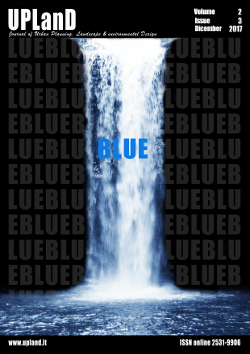Water valued in green infrastructure designs and human behaviours: Ecocentric values and their acceptance by human beings
Main Article Content
Abstract
Designers are anthropocentric in their processes and final products; green infrastructure in cities expresses people’s relationship to the environment in terms of resource management primarily. The natural world is transformed into urban green arrangement for the economic and cultural benefit of humans. Most experts believe that by offering people the opportunity to participate in running and preserving certain ecosystems could have a very positive impact to human health and wellbeing. Environmental psychology suggests that we can provoke heightened experiences in people’s minds by designing dynamic flowing water patterns and deep ponds. Designed landscapes have always blended with built manmade environment in a dynamic way. Natural and artificial landscapes interweave with built marvels of human creativity; historic places and urban areas develop and blend in harmony with natural habitat. Most historical cities emerged along water sources as dynamic ecosystems. The authors of this paper discuss the importance of water changing culture and behaviours in both urban and rural areas with reference to some noteworthy case studies and instances across Europe and, in particular, in recent cases of renaturation of rivers.
Downloads
Download data is not yet available.
Article Details
How to Cite
TracadaE., & VaroneF. (2017). Water valued in green infrastructure designs and human behaviours: Ecocentric values and their acceptance by human beings. UPLanD - Journal of Urban Planning, Landscape & Environmental Design, 2(3), 263-272. https://doi.org/10.6093/2531-9906/5419
Issue
Section
Articles

This work is licensed under a Creative Commons Attribution-NonCommercial-NoDerivatives 4.0 International License.
Authors who publish with this journal agree to the following terms:- Authors retain copyright and grant the journal right of first publication with the work simultaneously licensed under a Creative Commons Attribution License that allows others to share the work with an acknowledgement of the work's authorship and initial publication in this journal.
- Authors are able to enter into separate, additional contractual arrangements for the non-exclusive distribution of the journal's published version of the work (e.g., post it to an institutional repository or publish it in a book), with an acknowledgement of its initial publication in this journal.
- Authors are permitted and encouraged to post their work online (e.g., in institutional repositories or on their website) prior to and during the submission process, as it can lead to productive exchanges, as well as earlier and greater citation of published work (See The Effect of Open Access).
References
Blewitt, J. (2015). Understanding Sustainable Development. 2nd Edition. New York, NY & London, UK: Earthscan from Routledge, Taylor & Francis Group.
Holden, R., & Liversedge, J. (eds.), (2014). Landscape Architecture: An Introduction. London, UK: Laurence King Publishing Ltd.
Mell, I. (2016). Global Green Infrastructure. Lessons for successful policy-making, investment and management. New York, NY & London, UK: Routledge, Taylor & Francis Group.
Pearson, L.J., Newton, P.W. & Roberts, P. (eds.), (2014). Resilient Sustainable Cities: A Future. New York, NY & London, UK: Routledge, Taylor & Francis Group.
Roe, M., & Taylor, K. (eds.), (2014). New Cultural Landscapes. New York, NY & London, UK: Routledge, Taylor & Francis Group.
Sanpaolesi, P. (1975). Il centro storico di Firenze. Pisa-Florence, IT.
Sgobbo, A. (2017). Eco-social innovation for efficient urban metabolisms. TECHNE Journal of Technology for Architecture and Environment, 14, 335-342. doi: 10.13128/Techne-20812
Tracada, E. (1996). Line Performance Act. MA thesis, Manchester Metropolitan University, UK.
Tracada, E. (2003). The procession of Maria’s Servants and a huge proliferation of Art and Architecture in the Santa Maria Nuova Hospital in Florence. In P. Martyn, P. Paszkiewicz & F. Ames-Lewis (eds.), Art-Ritual-Religion (pp. 255-266). Warszawa, PL: Instytut Sztuki PAN.
Tracada, E. (2014). Saint-Guilhem-le-Désert: “Le Bout du monde”, “Inferno” and “Purgatorio in landscape. In F. Villemur (ed.), Dance Architecture Spatiality- Saint-Guilhem-le-Désert 2014 (pp. 116-122). Montpellier, FR: Éditions de l’Espérou.
Varone, F., & Caputi, P. G. (2017). Landscape Decoding in Urban City Planning. UPLanD – Journal of Urban Planning, Landscape & environmental Design, 2(1), 67-98.
Holden, R., & Liversedge, J. (eds.), (2014). Landscape Architecture: An Introduction. London, UK: Laurence King Publishing Ltd.
Mell, I. (2016). Global Green Infrastructure. Lessons for successful policy-making, investment and management. New York, NY & London, UK: Routledge, Taylor & Francis Group.
Pearson, L.J., Newton, P.W. & Roberts, P. (eds.), (2014). Resilient Sustainable Cities: A Future. New York, NY & London, UK: Routledge, Taylor & Francis Group.
Roe, M., & Taylor, K. (eds.), (2014). New Cultural Landscapes. New York, NY & London, UK: Routledge, Taylor & Francis Group.
Sanpaolesi, P. (1975). Il centro storico di Firenze. Pisa-Florence, IT.
Sgobbo, A. (2017). Eco-social innovation for efficient urban metabolisms. TECHNE Journal of Technology for Architecture and Environment, 14, 335-342. doi: 10.13128/Techne-20812
Tracada, E. (1996). Line Performance Act. MA thesis, Manchester Metropolitan University, UK.
Tracada, E. (2003). The procession of Maria’s Servants and a huge proliferation of Art and Architecture in the Santa Maria Nuova Hospital in Florence. In P. Martyn, P. Paszkiewicz & F. Ames-Lewis (eds.), Art-Ritual-Religion (pp. 255-266). Warszawa, PL: Instytut Sztuki PAN.
Tracada, E. (2014). Saint-Guilhem-le-Désert: “Le Bout du monde”, “Inferno” and “Purgatorio in landscape. In F. Villemur (ed.), Dance Architecture Spatiality- Saint-Guilhem-le-Désert 2014 (pp. 116-122). Montpellier, FR: Éditions de l’Espérou.
Varone, F., & Caputi, P. G. (2017). Landscape Decoding in Urban City Planning. UPLanD – Journal of Urban Planning, Landscape & environmental Design, 2(1), 67-98.

